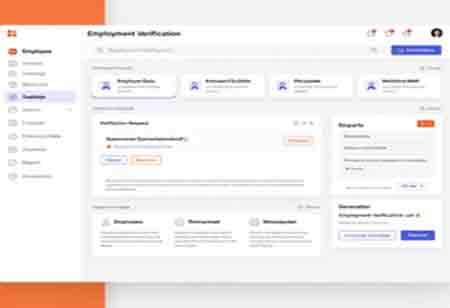THANK YOU FOR SUBSCRIBING
Be first to read the latest tech news, Industry Leader's Insights, and CIO interviews of medium and large enterprises exclusively from Hrtech Outlook
THANK YOU FOR SUBSCRIBING

By
HR Tech Outlook | Wednesday, August 06, 2025
Stay ahead of the industry with exclusive feature stories on the top companies, expert insights and the latest news delivered straight to your inbox. Subscribe today.
Employment history verification is essential to the hiring process, compliance initiatives, and workforce management. Organizations must verify candidates' past employment, confirm job titles, and establish dates of service to ensure that only qualified individuals are permitted to occupy specific roles or participate in designated reward programs. Historically, this verification process has been conducted manually through phone calls, emails, or document reviews, often resulting in delays and inconsistencies.
In response to these challenges, many organizations seek to enhance the efficiency and accuracy of their verification processes through automation. Modern technological solutions enable the automation of sourcing, validating, and reporting employment records, facilitating timely employment verification.
These automated platforms are designed to integrate seamlessly with existing human resource systems and third-party databases, ensuring compliance with privacy and labor regulations while providing real-time verification services. Organizations can significantly streamline their employment verification processes by minimizing manual intervention, leading to improved accuracy and efficiency.
Improving Accuracy and Reducing Verification Times
The primary advantage of automated employment verification lies in its capacity to enhance accuracy, thereby significantly reducing the duration required for processing verifications. The conventional manual process is susceptible to human errors, including inaccuracies in communication, transcription, and information interpretation. In contrast, automated systems mitigate these risks using verified digital records and standardized workflows.
Upon receiving consent from an employee or candidate for verification, the platform can directly obtain employment data from secure sources such as payroll systems, employment databases, or verified records maintained at that time. This data is subsequently evaluated against the specific verification request.
As a result, the turnaround time for verifications may be reduced to minutes rather than days. This expeditious process facilitates more rapid onboarding and benefit eligibility assessments, benefiting employers and governmental agencies involved in the application procedure. Moreover, automated systems ensure that all validations adhere to consistent standards, which helps to maintain uniformity and reduce discrepancies that may arise from subjective interpretations or varying practices among personnel.
Human Resources departments will find that the need for routine correspondence with previous employers has been diminished, as the verification process is now streamlined. By centralizing employment verification on a unified platform, organizations can redirect focus toward higher-value tasks rather than basic verification requirements. This modernization offers enhanced visibility into historical workforce activity and recruitment decisions, ultimately improving decision-making and audit readiness.
Fulfillment of Compliance Requirements and Data Safety Standards
Employment verification frequently involves handling sensitive personal data, making it an essential consideration in compliance regulations and data security. Automated platforms are designed to address these imperatives, incorporating stringent access controls, enforced encrypted communication protocols, and established audit mechanisms to protect information throughout the verification process. Such platforms typically feature configurable settings that enable organizations to define user roles, manage data retention policies, and maintain comprehensive access and activity logs.
Concerning legal compliance, automated employment verification facilitates adherence to labor laws and industry-specific regulations. For instance, employers in certain jurisdictions must verify residency or work authorization as part of the employment eligibility verification process. Automated systems ensure the monitoring and validation of documentation by regional requirements, thereby minimizing the risk of overlooked information. This standardization allows organizations to demonstrate compliance during inspections or audits by generating records that are ready for assessment.
Furthermore, these platforms are designed to align with global data privacy laws. Consent-driven workflows ensure that individuals provide authorization for releasing their employment data, adhering to best practices in privacy and fostering transparency between employers and candidates. Additionally, secure authentication mechanisms guarantee that only authorized individuals can access or disseminate employment information, mitigating the risk of unauthorized disclosure or identity fraud.
Enhancing Candidate and Employee Experience
Automated employment verification platforms significantly enhance the experiences of both candidates and employees. Candidates utilizing traditional systems often encounter inconveniences, such as needing documentation or contacting former employers. This can lead to delays in receiving job offers, completing background checks, or applying for necessary services such as housing or loans. Automated platforms alleviate these challenges by allowing candidates to electronically authorize the verification of their information, typically through a secure, web-based portal.
This convenience accelerates the hiring process and alleviates stress for candidates. Additionally, employees may require income or employment verifications for personal purposes, such as mortgage or rental applications. The ability to quickly generate these verification documents can greatly reduce their burden. Several platforms also grant users control over how their data is shared, instilling confidence that their information is managed appropriately.
From the employers' standpoint, an efficient verification process enhances organizational reputation and improves recruitment outcomes. Candidates are more likely to view an organization favorably when administrative tasks are managed effectively and transparently. Ultimately, the efficiencies gained through automation can contribute to enhanced HR service delivery and strengthen the overall employment brand.



